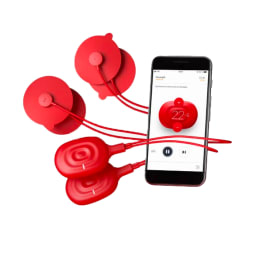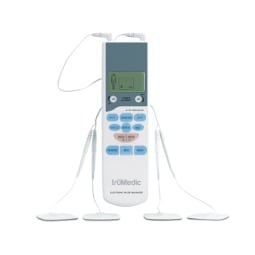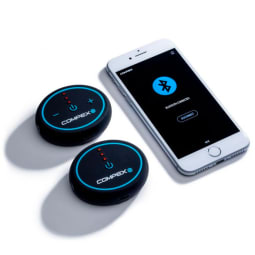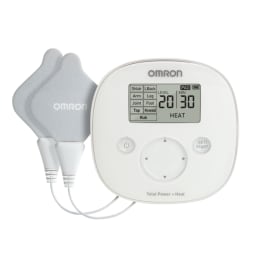Advertisement
The 5 Best TENS Units For Back Pain Of 2022 For Quick Relief


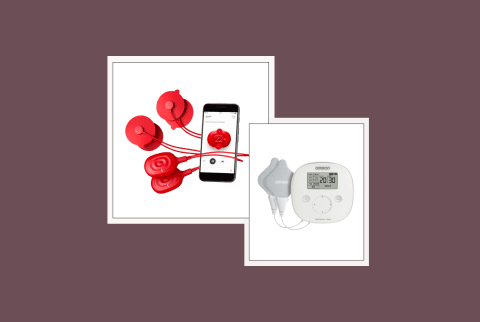
If you're considering a transcutaneous electrical nerve muscle stimulation (TENS) unit, you're likely experiencing some degree of chronic pain—and you're not alone. A 2019 National Health Survey found that over 50 million U.S. adults1 (about one in five) reported pain on most days, if not every day. Chronic pain has been linked with a reduced quality of life and can be extremely disruptive to your daily routine. While some therapeutic treatments and modalities are expensive and intrusive, the best TENS units for back pain can be an effective and efficient pain-relief method.
A TENS unit consists of an electrical signal generator, a battery and a set of electrodes (adhesive pads). In order to understand how TENS units affect pain, we spoke with experts to dive deeper into the neurophysiologic mechanisms of pain control. Below, learn more about who these devices are good for, and find our picks for the best TENS units for back pain.
The best TENS units for back pain:
What is a TENS unit?
A TENS unit uses low-voltage electrical currents to stimulate your nerves and ease pain in your body. These devices have been used for relief from neuropathic pain, fibromyalgia, osteoarthritis pain, and chronic low-back pain2. TENS can also be used as part of a postoperative plan of care.
These machines are battery-powered, with small electrodes that are placed on your skin, either where you have pain or on corresponding trigger points. The belief is that these electrical currents are not so much treating the pain but rather changing your perception of it by blocking the transmission of pain signals or raising the level of endorphins in your body.
"Sensory-level treatments use what is known as the gate control theory, where non-painful stimulus closes the gate on (overrides) the transmission of painful impulses," explains Chad Starkey, Ph.D., author of Therapeutic Modalities. "In addition to the sensory effects of sensory-level pain control, motor-level pain control uses relatively intense muscle contractions to release endogenous opiates (the body's morphine-like substances). This arguably provides better, longer pain relief than sensory level but does require a deeper understanding of electrical stimulation parameters and neuroanatomy."
The noxious-level TENS method typically involves a point-and-shoot probe, or a large, dispersive electrode and a smaller electrode where the current is concentrated. This form of TENS is less studied, and while your physical therapist may experiment with this noxious-level TENS, at-home TENS units should be used for sensory level, gate control theory pain relief only. "I do not recommend noxious-level stimulation for home use," Starkey confirms.
How to use a TENS unit for back pain.
The best way to ensure you're using your TENS unit for back pain correctly is to speak with a medical professional. Any reputable machine should come with extensive instructions—and this is not an instance where you want to skip the instruction manual. "TENS is a relatively safe treatment, so long as those instructions are followed," Starkey confirms.
That said, before you decide to charge up your TENS unit, Starkey says you'll want to make sure you have an understanding of where your pain is coming from. "It's cliché but TENS (or anything else) should not be used to treat pain of unknown origin or used for more than two weeks without being examined by a medical professional."
As for pad placement during sensory level pain control (no muscle contraction), Starkey recommends an "X" pattern with the painful area at the center of the X. The electrodes on each set of wires should be placed so that the current crosses over the area in pain.
In terms of frequency of use, "Sensory-level pain control can be used for days at a time," Starkey advises. He recommends moving the electrodes slightly with each use to avoid irritation from the adhesive.
The TENS unit should feel like a tingle or buzz that gradually increases in intensity to a sharp, prickly sensation. If the TENS treatment is successful, you should feel some pain relief within the first 30 minutes of treatment. If it is not successful, change the electrode placements and try again. And if you're seeking 24-hour pain control, portable units are best.
How we picked:
Expert input
We spoke with experts to understand how TENS units work and took this into consideration when selecting our recommendations.
Reviews
A wide range of feedback is important, so we read reviews for each product to help narrow down our top picks and inform our pros and cons.
Portability
You can't choose when you have back pain, so portability is important when it comes to pain relief devices. We kept this in mind when evaluating each product.
Features
Each TENS unit comes with different features, modes, and capabilities. We prioritized products that have preset modes, customization abilities, and are easy to use.
Our picks for the best TENS units for back pain:
Pros:
- Long battery life
- Sleek travel case
- App with guided methods
Cons:
- Some say the pads lose stickiness quickly
Battery life:
up to 20 hoursNumber of pads:
6Therabody's PowerDot Duo is an easy-to-use device with app-controlled capabilities. If this is your first time trying out TENS, this unit is a great place to start. The PowerDot app has a ton of helpful information to guide you through where to place the pads and how to choose the right intensity. Choose from preset settings or customize to your own preferences. It's also sleek and portable, with a simple carrying case you can easily throw in your gym bag or luggage.
Pros:
- Portable & lightweight
- Preset modes for different body parts
Cons:
- Not chargeable
Battery life:
Not chargeableuses four AAA batteriesNumber of pads:
4This affordable, pulsing TENS unit has preset programs for different muscle groups: back, shoulder, joint, hand-leg, and sole. Simply select your program using the large LCD screen, and choose between standard massage, beat, or knead. You can then adjust the speed and intensity until you find what offers the best relief for you. It's lightweight and a great option for travel or any time you're on the go.
Advertisement
Pros:
- App-enabled
- Also features NMES
Cons:
- Short battery life
- Only 2 pads
Battery life:
up to 6 hoursNumber of pads:
2Budget-friendly for a wireless device, this mini TENS unit is great for on-the-go relief. In addition to TENS, it also features NMES, which is meant to improve muscle performance. The app comes equipped with six fitness programs, which you're meant to perform while wearing the two electrode pods to manage muscle soreness, increase blood circulation, loosen stiff muscles, and temporarily reduce pain.
Pros:
- Heated
- Digital screen for easy control
- Portable
Cons:
- Only 2 pads
Battery life:
Not specifiedNumber of pads:
2plus 2 heat gel padsFor an even more powerful pain relief experience, this unit uses a combination of heat and TENS. You can also use the TENS stimulator alone, if you'd prefer no heat. The settings are extremely customizable, with preset modes for your arms, lower back, legs, feet, joints, and shoulders. It's also a massager and can be set to tap, knead, or rub, with 20 levels of intensity to choose from for each.
Advertisement
Pros:
- 40 pads
- Advanced technology
Cons:
- Not chargeable
Battery life:
Not chargeableuses one 9V batteryNumber of pads:
40This TENS device is made by the same manufacturer as clinically used electronic stimulation units, so the quality is top-notch. It has 8 TENS programs, 6 neuromuscular electrical stimulation (NMES) programs, a whopping 40 pads, and a unique HAN TENS waveform, which provides the noxious stimulus to release endogenous endorphins. Keep in mind, this is definitely a more advanced TENS unit and should only be used by those who fully understand the technology. It's best to discuss with your doctor if you aren't sure if this is right for you.
FAQ
Does a TENS unit help with chronic back pain?
While more research is needed to determine how exactly TENS units help with chronic pain, and how effective they truly are, a 2022 scientific review suggested that TENS can be effective in relieving pain.
Where do you put a TENS unit for back pain?
The pads can either be placed on the area of pain or on trigger points. Starkey recommends an "X" pattern with the painful area at the center of the X. Your TENS unit will come with instructions and likely built-in modes that help guide you on where to put the pads.
How often should you use a TENS unit for back pain?
Regarding the frequency of use, Starkey says, "Sensory-level pain control can be used for days at a time." He recommends moving the electrodes slightly with each use to avoid irritation from the adhesive.
The takeaway.
Chronic pain can be frustrating and disruptive, to say the least. These TENS units are a simple way to help relieve that pain at home. Simple stretching routines and acupressure can also be extremely effective. Just make sure you're working with a doctor to determine the underlying cause, too. If your pain is keeping you up at night, you might want to take a look at your sleep environment and consider one of these best mattresses for back pain.
